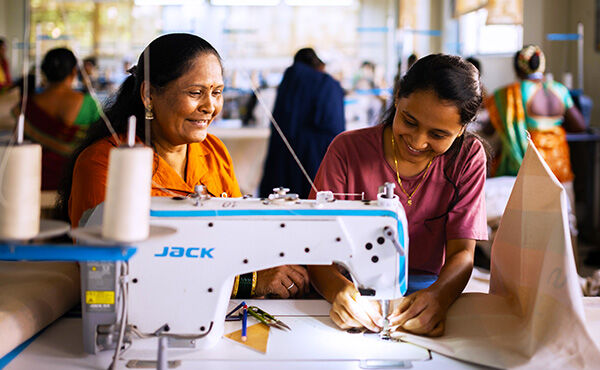I am sure we can all recall a time in elementary school when our teacher caught us day-dreaming and whipped our mind back into the present moment by sternly declaring our name out loud followed by those two famous words: “Pay Attention!”
I don’t know about you, but I didn’t have much training in “paying attention.” I am not sure I even knew what that meant. No one had ever really explained it to me. And I certainly hadn’t consciously practiced it.
Now, as an adult woman who earns a living through helping others pay attention, I have come to learn that mindfulness is not something we have to learn. It is something we have to remember (and practice). The closer we are to our natural state, the easier it is to remember.
Being naturally mindful
One of my favourite things is to watch my nine-month-old son’s sense of wonder, exploration and curiosity. A small white daisy in a field of green grass can hold his admiration for many minutes. At mealtime, he becomes completely mesmerised by the shape, feel, taste and texture of a silver spoon. Each morning, watching me brush my teeth is an utterly fascinating event worthy of his full attention.
I would dare to argue that young children are naturally mindful. Mindfulness helps us become aware of what is happening in the present moment. We pay attention to whatever is in front of us, whatever we are doing or feeling or experiencing now. It is such a powerful practice because it does not seek to take us out of our daily lives, but bring us intimately in to them. We come to a greater sense of calm and serenity in the simplest of everyday tasks.
The influence of parents
As parents or guardians, I believe we can greatly influence whether or not this natural sense of awareness is enhanced or diminished amidst a child’s ever-widening world of distraction. Thich Nhat Hanh, the famous Buddhist monk and teacher, wrote, “You cannot transmit wisdom and insight to another person. The seed is already there. A good teacher touches the seed, allowing it to wake up, to sprout and to grow.”
If we can encourage the seed of mindfulness to flourish from an early age, we are guiding children to a realisation of their own inner self, power and peacefulness. These are invaluable resources, which they can then rely on through the inevitable pain and challenges to come.
Anything can be done mindfully—drinking, eating, washing dishes, walking, breathing, bathing, speaking. And the first step to nourish the seed of mindfulness in the children around you is to nourish the seed within yourself. Children are incredibly sensitive beings. If you attempt to guide them to a state of peaceful awareness when you, yourself, are feeling stressed and distracted, they will pick up on it. The peace starts with you.
Nourishing the seed of mindfulness in children
Ideas are great. Concepts are fascinating. I can give you testimonial after testimonial from parents reporting that their children, who have been trained in mindfulness, experience better focus and concentration; increased calm; decreased stress and anxiety; improved impulse control; have increased self-awareness; find skillful ways to respond to difficult emotions and are more empathetic of others. But we need to begin with simple and effective ways to introduce mindfulness to our children. So, here are a few to get you started :
1. Start with what is in front of you
Mindfulness is a practice of bringing your mind fully into the present moment. You don’t need to set up situations to practice mindfulness. Begin with what you and your children do every day.
At mealtime, encourage your son or daughter to pause before eating, to begin relating to the food, even asking questions like:
‘Where did you come from carrots?’
‘What do you taste like?’
‘What emotions or feelings do you bring to my body?’
When you take a walk, ask your child to activate their magical or superpower senses:
What do they see?
What do they hear? (even the sounds that are really, really far away)
What do they feel?
If you make things fun and imaginative, they are more likely to respond in a positive way.
2. Play with mindfulness
Children love to play, and setting up games that nourish the seed of mindfulness can be really fun and engaging. One of my favourite ones is given in Thich Nhat Hanh’s book, Planting Seeds: Practicing Mindfulness with Children. (A book I highly recommend you to read). Here is the exercise I love:
- Fill a large, clear vase with water, and set out different containers of coloured sand.
- Explain that the vase is our mind, and the different colours of sand are our thoughts.
- You then begin asking your child, or children (this is often very powerful when done in a group) various questions, such as:
What kind of thoughts do you have when waking up?
What thoughts do you have when you go to school?
In the afternoon?
Before bed?
- After each question, each child can pick a colour of sand that feels right for their thoughts or feelings and sprinkle a handful in the vase, while sharing their emotions. You (or another child) can begin stirring the water so the sand swirls around.
- As you stir the water faster, you can explain that our minds are like this when we are hurried, stressed, angry or upset. Ask the children:
Can you see things clearly in this state?
Is it a pleasant state?
Can you name some examples of when you feel this way?
- Then ring a bell and stop stirring. Tell the children: “Let’s breathe with the bell and observe all the sand as it slowly settles to the bottom of the vase.” They will often find this quite peaceful and relaxing.
(This is what happens to our mind when we are mindful of our body and breathing. What is the water like now? The thoughts and feelings are still there but rest peacefully at the bottom, because we know how to return to our breathing to calm them).
A beautiful learning experience
This, and other mindfulness games, can be a beautiful learning experience for both you and your children. It asks for your time and creativity, but by giving your child this time and creative energy, you are giving them a precious and invaluable gift. You are fostering a sense of self-awareness and attention, which they will always have access to.
I’m not sure about you, but I love to imagine a world where compassion and mindfulness are taught alongside elementary school mathematics and geography—the lessons of the Self, alongside the lessons of the world. But until then, let’s begin at home.





